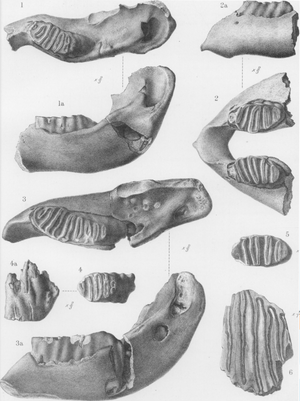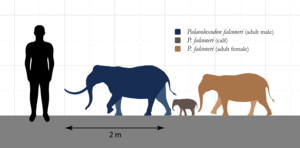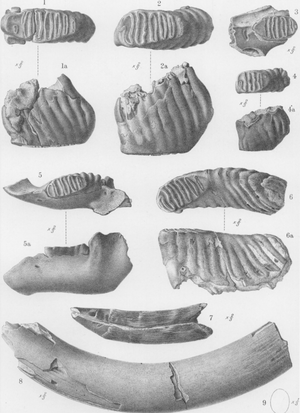Cyprus dwarf elephant facts for kids
Quick facts for kids Cyprus dwarf elephant |
|
|---|---|
 |
|
| Molar and jaw fragments from type locality | |
| Scientific classification | |
| Genus: |
Palaeoloxodon
|
| Species: |
cypriotes
|
| Synonyms | |
|
|
The Cyprus dwarf elephant (scientific name: Palaeoloxodon cypriotes) was a unique type of dwarf elephant. It lived on the island of Cyprus a very long time ago, during the Late Pleistocene period. Imagine an elephant only about 1 metre (3.3 ft) tall at its shoulder! That's how small these fully grown elephants were. They were likely related to the much larger straight-tusked elephant found in Europe and Asia. On Cyprus, this dwarf elephant and the Cypriot pygmy hippopotamus were the only big animals. Sadly, they disappeared around 12,000 years ago, which was around the time humans first arrived on the island. Scientists are still studying if human activities played a role in their disappearance.
Contents
Discovering This Ancient Elephant
The first signs of the Cyprus dwarf elephant were found in 1902. A scientist named Dorothea Bate discovered their bones in a cave. This cave was located in the Kyrenia Mountains in northern Cyprus.
Dorothea Bate first wrote about these amazing finds in 1903. She named the species Elephas cypriotes back then. Later, in 1905, she shared more details about her discoveries. The cave where she found them is still one of the best places to find these elephant remains.
Today, scientists have found bones of the Cyprus dwarf elephant in over 20 different spots across the island. These places include rock shelters, caves, and areas near old rivers or ponds. Each new discovery helps us learn more about these tiny elephants.
How the Cyprus Dwarf Elephant Evolved
Scientists believe the Cyprus dwarf elephant came from a slightly larger, but still small, elephant called Palaeoloxodon xylophagou. This older species lived in Cyprus during the Middle Pleistocene period, hundreds of thousands of years ago. Both of these dwarf elephants are thought to have descended from the huge straight-tusked elephant (Palaeoloxodon antiquus). This giant elephant lived across Europe and Western Asia.
Journey to an Island Home
Cyprus has always been an island, even when sea levels were much lower. This means the ancestors of these elephants must have reached the island by swimming! They likely swam from what is now southeastern Anatolia (Turkey) to the Karpas Peninsula in northeast Cyprus. This was a long swim, at least 60 kilometres (37 mi), which is quite a distance for an elephant. It's possible they could see the island from the mainland, encouraging them to make the journey.
Why Did They Become So Small?
Once on the island, these elephants became much smaller over many generations. This process is called insular dwarfism. It happens when large animals live on islands where there is less food. Also, there might be fewer predators or less competition for resources. Being smaller helps them survive better in these conditions.
The Palaeoloxodon xylophagou was already much smaller than its mainland ancestor. The Cyprus dwarf elephant then became even tinier. Its skull also changed, becoming wider and lower compared to its huge relatives.
What Did the Cyprus Dwarf Elephant Look Like?
Most of what we know about Palaeoloxodon cypriotes comes from small bone pieces. Scientists have found many molar teeth, parts of tusks, and a few other bones like a femur (thigh bone).
Size and Weight
When fully grown, these elephants were only about 1 metre (3.3 ft) tall at the shoulder. This makes them one of the smallest dwarf elephant species ever discovered! They were similar in size to the dwarf mammoth from Crete (Mammuthus creticus) and the dwarf elephant from Sicily (Palaeoloxodon falconeri).
Imagine an elephant weighing only about 200 kilograms (440 lb)! That's how much the Cyprus dwarf elephant weighed. Their huge ancestors, the straight-tusked elephants, weighed around 10 tonnes. This means the Cyprus dwarf elephant lost about 98% of its original body weight!
Teeth and Tusks
Their molar teeth were much smaller than those of their mainland relatives. They were only about 40% of the size. Even though they were smaller, the teeth still had a similar shape. They had fewer grinding plates (called lamellae) on their molars. This helped them chew their food effectively, even with smaller teeth.
Scientists think that the molars of the Cyprus dwarf elephant grew very slowly. This might mean that, like other dwarf elephants, they lived for a long time, similar to full-sized elephants. Their tusks were also different. They were more curved and had an oval shape when cut across.
Life and Habitat of the Dwarf Elephant
The bones of the Cyprus dwarf elephant suggest it was good at moving on hilly and steep land. This is different from many modern elephants. Fossils show they lived at various heights, even high up in the Troodos Mountains. One fossil was found about 300 metres (980 ft) up Mount Olympus, the tallest mountain on the island.
Who Else Lived on Cyprus?
During the time the dwarf elephant lived, Cyprus had very few large animals. The only other big mammal was the Cypriot pygmy hippopotamus. Other land mammals included the Cypriot mouse, which still lives there today, and a type of genet (Genetta plesictoides). Because there were so few large animals, the dwarf elephant likely had no natural predators.
Scientists have found fewer elephant bones than hippopotamus bones. This might mean the elephants were better at avoiding natural traps, like muddy areas, where animals could get stuck.
What Was Cyprus Like Back Then?
Cyprus doesn't have many natural rivers that flow all year round. This makes it hard for scientists to study ancient plant life and climate using pollen. However, it's thought that the island's plant life might have been similar to today. This would include a mix of forests, mostly on mountain slopes, and open areas like grasslands.
Why Did the Cyprus Dwarf Elephant Disappear?
The most recent bones of the Cyprus dwarf elephant were found at a site called Aetokremnos in southern Cyprus. These bones are about 11,500 to 12,000 years old. This time period is when the Pleistocene ice age was ending and the Holocene epoch began.
Humans Arrive on the Island
Interestingly, the Aetokremnos site also shows some of the earliest signs of humans living on Cyprus. People are thought to have arrived on the island around 12,000 to 13,000 years ago. Some scientists believe that the bones of dwarf elephants and hippos found at this site were brought there by these early humans. This could mean that humans interacted with these animals, which might have led to their extinction. However, other scientists disagree. They think the bones might have ended up there naturally, separate from human activity.
How Many Elephants Were There?
A study from 2024 estimated that when humans first arrived, there were about 5,000 dwarf elephants on Cyprus. These elephants had slow life cycles, meaning they didn't reproduce very quickly. This made them vulnerable to changes in their environment.
The study suggested that if more than 200 elephants were lost each year, the species would be at risk. If more than 350 were lost annually, extinction would become very likely. Even a small human population could have caused this. This suggests that the dwarf elephants might have disappeared relatively quickly after humans settled on Cyprus. Scientists estimate they might have gone extinct as recently as 9,100 to 10,300 years ago.
See also
- Palaeoloxodon tiliensis a species of dwarf elephant native to the Greek island of Tilos, possibly survived later than P. cypriotes



